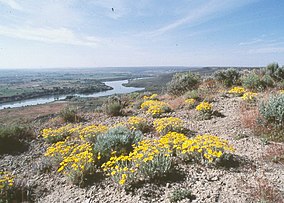Hagerman Fossil Beds National Monument
| Hagerman Fossil Beds National Monument | |
|---|---|
 View over Snake River in the National Monument | |
 | |
| Location | Twin Falls County / Gooding County, Idaho, United States |
| Nearest city | Hagerman, ID |
| Coordinates | 42°47′25″N 114°56′43″W / 42.79028°N 114.94528°WCoordinates: 42°47′25″N 114°56′43″W / 42.79028°N 114.94528°W |
| Area | 4,351 acres (17.61 km2)[1] |
| Authorized | November 18, 1988 |
| Visitors | 25,982 (in 2016)[2] |
| Governing body | National Park Service |
| Website | Hagerman Fossil Beds National Monument |
| Designated | 1975 |

Hagerman Fossil Beds National Monument near Hagerman, Idaho, contains the largest concentration of Hagerman horse fossils in North America. The fossil horses for which the monument is famous have been found in only one locale in the northern portion of the monument called the Hagerman Horse Quarry. The 4,351-acre (17.61 km2) monument is internationally significant because it protects the world's richest known fossil deposits from the late Pliocene epoch, 3.5 million years ago. These plants and animals represent the last glimpse of that time that existed before the Ice Age, and the earliest appearances of modern flora and fauna. This is also significant because the fossils present during this period of the Pliocene represent species which were alive during the early stages in the evolution of man, albeit on a different continent. The fossil beds were designated a National Natural Landmark in 1975.[3]
Notable fossils[]
- Hagerman horse, Equus simplicidens, formerly known as Plesippus shoshonensis
- Camelops, an extinct genus of camel that once inhabited North America
Many other species are also found in the fossil record, including mastodons, saber-toothed cats, and bone-crushing dogs (Borophaginae), as well as various species of fish, frog, vole and beaver.
See also[]
References[]
- ^ "Listing of acreage as of December 31, 2011" (PDF). Land Resource Division, National Park Service. Retrieved 2012-05-14.
- ^ "NPS Annual Recreation Visits Report". National Park Service. Retrieved 2017-08-18.
- ^ "Hagerman Fossil Beds". nps.gov. National Park Service.
External links[]
 Media related to Hagerman Fossil Beds National Monument at Wikimedia Commons
Media related to Hagerman Fossil Beds National Monument at Wikimedia Commons Hagerman Fossil Beds National Monument travel guide from Wikivoyage
Hagerman Fossil Beds National Monument travel guide from Wikivoyage- Official Hagerman Fossil Beds National Monument website
- IUCN Category III
- National Park Service National Monuments in Idaho
- Fossil museums
- Fossil parks in the United States
- Museums in Hagerman, Idaho
- Natural history museums in Idaho
- National Natural Landmarks in Idaho
- Paleontology in Idaho
- Protected areas of Gooding County, Idaho
- Protected areas of Twin Falls County, Idaho
- Neogene Idaho
- Pliocene United States
- Pliocene paleontological sites of North America
- Protected areas established in 1988
- 1988 establishments in Idaho
- 1988 in paleontology
- Natural history of Idaho

